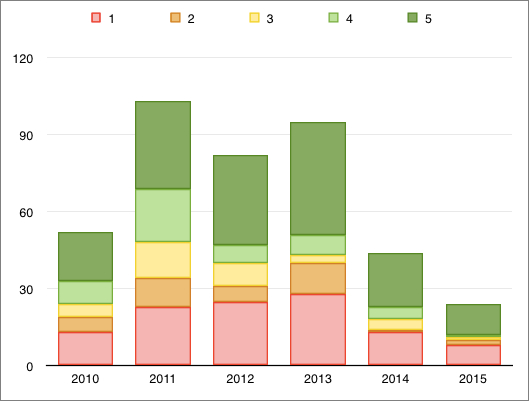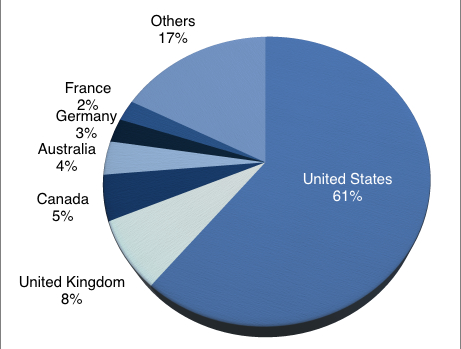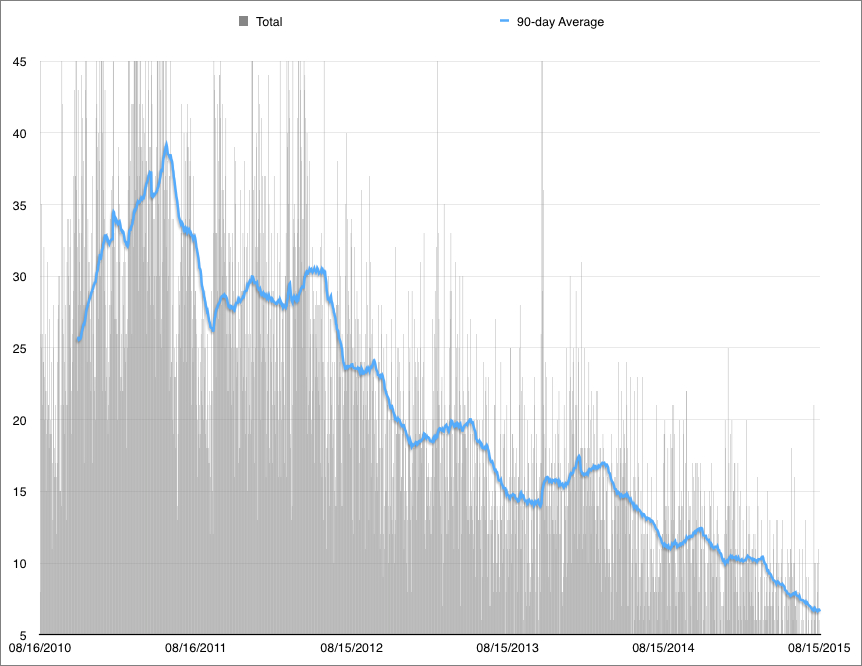
I have always enjoyed reading real accounts from developers on the App Store. As Portfolio turns five years old this August, I figured it was my turn to do the same. Enjoy!
Numbers
Portfolio sold its first copy on August 16, 2010. In the five years since it has been sold 37,805 copies for a net to me of $364,797. Apple’s share during this same time period was approximately $156,342. It has been at three price points during this time: $9.99, $12.99, and $14.99.
The best sales day ever was on February 3, 2011, in which 200 copies were sold. My revenue from that day was $2,102.
Out of those 37,805 copies sold, 210 have been refunded. Only 400 users have left reviews, weighing slightly more towards loving the app than hating it.

Over 71 releases it has been downloaded 692,993 times. 61% of all downloads have been in the United States with other countries dividing up the remaining 39% with no more than single digit shares.

Analysis
While the sales number is impressive, especially for a single person development team, the trend is more worrying – people just aren’t buying apps like they used to, and I don’t think I have saturated the market. The revenue decline has been accelerating for a little over three years now, and it is reaching the level where I can no longer afford to devote as much time to the app as I once was able to – it alone can’t support me.

I have always charged a sustainable price, starting first at $9.99 and then raising it to $14.99. As the revenue has declined I have experimented with price points at both $12.99 and $9.99 again but found that revenue stayed roughly the same. The price is now back at $14.99.
My feeling is that this decline in revenue is attributable primarily to a few factors:
- App discoverability is hopelessly broken. I believe I rank where I do solely because I was an early mover and have enough momentum behind me to maintain my search ranking. Still, it’s almost impossible to find an app unless you know the exact one you’re looking for.
- Users are being conditioned by freemium and underpriced apps to be unwilling to pay a sustainable price. This phenomenon seems to be somewhat unique to the mobile app market.
- I have never charged for an update. While the App Store itself doesn’t directly support this, there is a track record of other apps doing it by listing under a new App Store entry. I believe this to be my single biggest mistake in this endeavor and given the chance to do it again I would have made each major update a paid one.
Competition has never been a problem for Portfolio. If anything it has pushed me to innovate and improve it faster. When it first launched, there were a number of other similar apps that were released close to the same time. Over time most of those fizzled, and now there is only one left (the others are still mostly available for sale but have not been updated in years). The developer of that app chose a slightly different track and has a lower app cost with an in-app purchase to enable video support.
The top charts have also never been a problem. While many developers have complained about the top charts, I believe the top grossing in the Photo & Video category has had a significant effect on my sales over the years. Prior to the introduction of Newstand and the flooding of the charts with magazines (I feel these would have been better placed in a dedicated publication category rather than alongside regular apps), I consistently ranked close to number 10. That visibility seemed to be self-reinforcing as any drop from that spot resulted in a lower daily sales average until working my way back up.
One area that has been tough are the reviews. I have always had a love/hate relationship with reviews. A couple five star reviews will greatly boost sales, but even a single one star one can kill them. Of those leaving one star reviews, fewer than 5% of them ever contacted me for support. Other developers can definitely attest to this: many one star reviews complain about things and are completely incorrect, but because responding to a review is impossible, it sits there as a scar forever. The same applies to reviews complaining about something since fixed in a later update.
Lastly, media coverage at the opening of the App Store was substantially higher than it is now. In its first 18 months Portfolio had more media coverage than I have ever been able to get for all other apps I’ve since made combined. It’s just not as hot of a topic anymore, so media outlets are focusing elsewhere.
The Future
I don’t know what the future holds, but I don’t think the App Store will be a significant part of it. As fewer and fewer users are willing to pay the software prices of even five years ago, developers will not be able to afford to put the time into apps of any substance, especially ones with a niche audience.
For myself I’m planning on testing the waters on the Mac again with a photography program called Wall Displays. Between that and other sources of revenue I have and am developing, I am hoping to diversify my income sources to better insulate myself against any one of them dropping off suddenly.